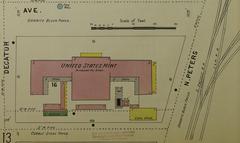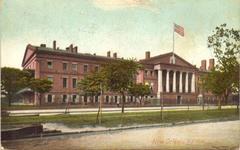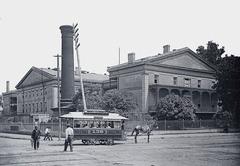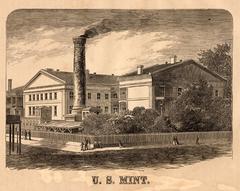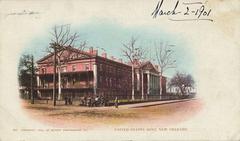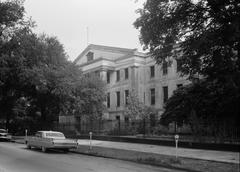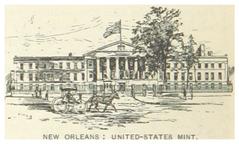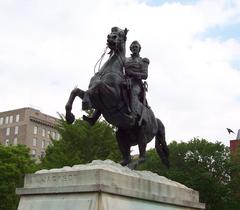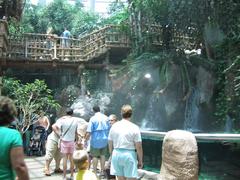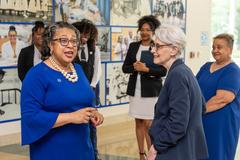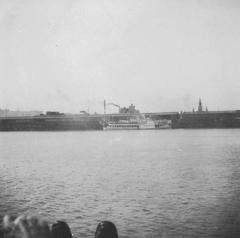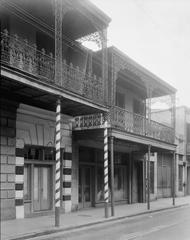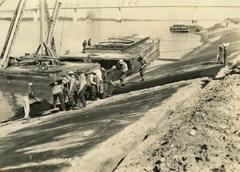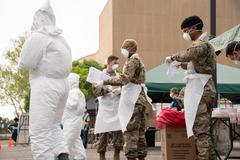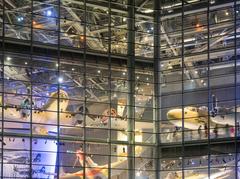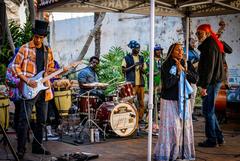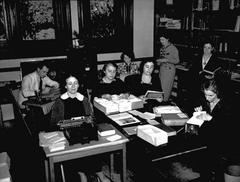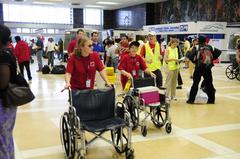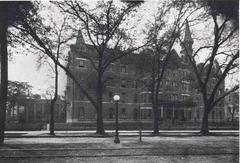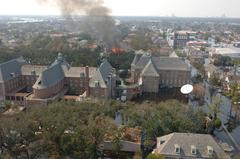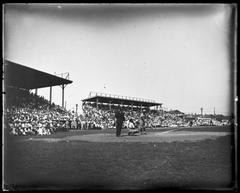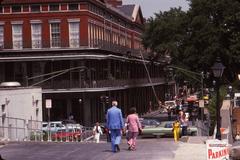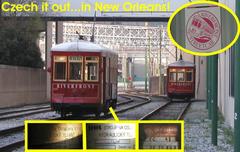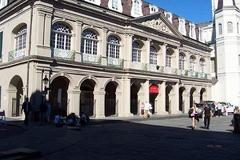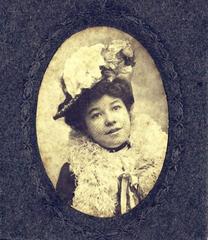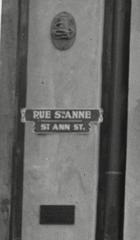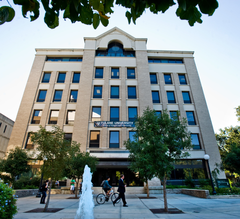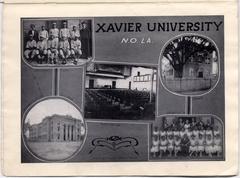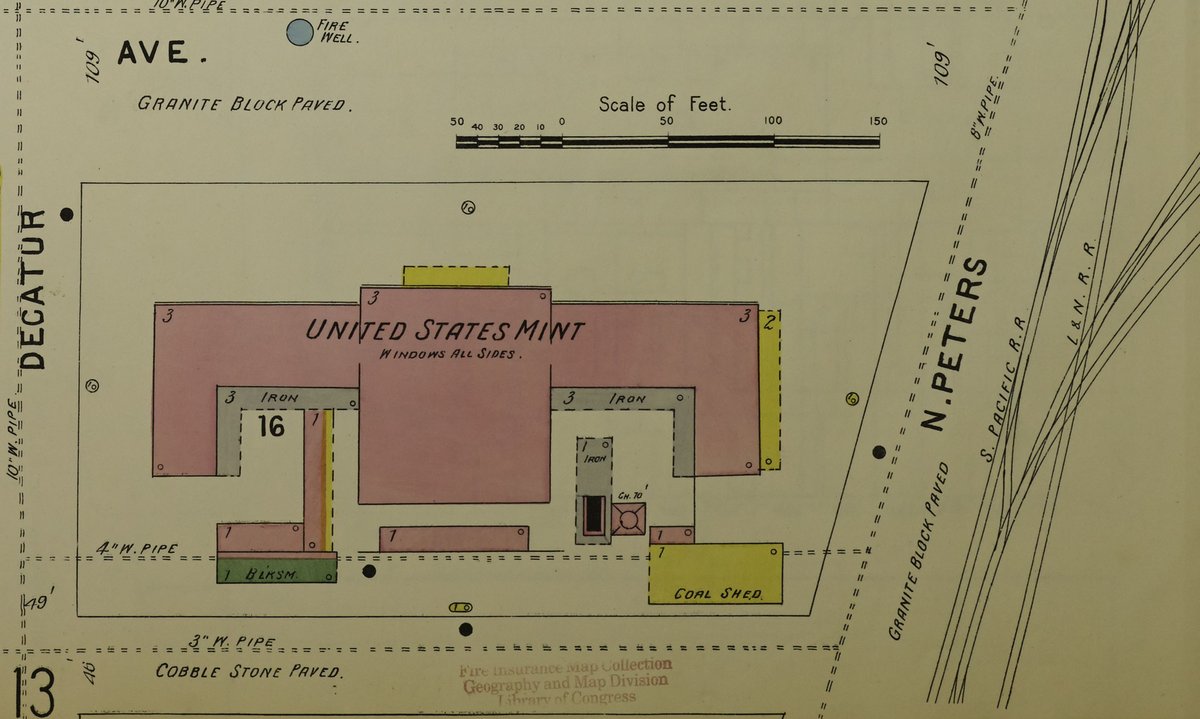
New Orleans Mint Visiting Hours, Tickets, and Historical Sites Guide
Date: 14/06/2025
Introduction
The New Orleans Mint stands as a prominent testament to the city’s storied past—where American coinage history meets the birthplace of jazz. Founded in 1835 and operational from 1838, this iconic building has served as a U.S. Mint, federal prison, storage facility, and, today, a vibrant museum and cultural hub. Its strategic location at the mouth of the Mississippi River helped propel economic expansion in the South and West, while its current role as the home of the New Orleans Jazz Museum embodies the city’s enduring creative spirit (Great American Coin Company; GovMint). This comprehensive guide provides detailed information on the Mint’s history, visiting hours, ticketing, accessibility, highlights, and tips for planning your visit.
Table of Contents
- Introduction
- Founding and Strategic Importance
- Early Operations and Coinage (1838–1861)
- Civil War and Confederate Control (1861–1862)
- Reconstruction and Second Era of Coinage (1876–1909)
- Post-Mint Uses and Preservation
- Visiting the New Orleans Mint: Practical Information
- Museum Layout and Visitor Experience
- Exhibits and Key Attractions
- Events, Performances, and Community Engagement
- Planning Your Visit: Tips and Suggestions
- Frequently Asked Questions (FAQ)
- Conclusion
- References
Founding and Strategic Importance
The New Orleans Mint was established by Congress in 1835 to address a shortage of coinage in the rapidly expanding southern and western United States. New Orleans, then a bustling port and the nation’s fifth-largest city, was chosen for its economic and geographic significance. The Mint was constructed on the former site of Fort St. Charles and designed in Greek Revival style by architect William Strickland (HNOC). Construction began in 1835, and by 1838, the Mint opened with a striking façade on Esplanade Avenue (GovMint).
Early Operations and Coinage (1838–1861)
Operations commenced in 1838, with the first coins—silver dimes—struck that year. The Mint quickly became vital, producing nearly every denomination of U.S. silver and gold coinage marked with the distinctive “O” mintmark (USACoinBook). The Mint’s strategic location enabled it to convert foreign coins into U.S. currency, supporting the vibrant trade in New Orleans. By the Civil War, the Mint had produced millions of coins, valued at more than $307 million (Wikipedia).
Civil War and Confederate Control (1861–1862)
With Louisiana’s secession in 1861, the state seized the Mint, briefly continuing to mint U.S. coins. Control soon shifted to the Confederacy, making the New Orleans Mint the only U.S. Mint to operate under three governments: United States, State of Louisiana, and Confederate States (GovMint). Confederate coinage from the Mint is exceedingly rare, with only four original Confederate half dollars known today. Union forces captured New Orleans in 1862, ending the Mint’s coin production until after the war (HNOC).
Reconstruction and Second Era of Coinage (1876–1909)
The Mint reopened as an assay office in 1876 and resumed coinage in 1879, focusing heavily on Morgan Silver Dollars, dimes, quarters, and gold coins. The Mint even struck coins for foreign governments, including millions of 20-centavo pieces for Mexico (PCGS). By 1909, the Mint’s role was reduced as new mints opened elsewhere, and it was decommissioned in 1911. Over its operational years, it produced over 427 million coins (USACoinBook).
Post-Mint Uses and Preservation
After coin production ceased, the building served as an assay office, federal prison, Coast Guard storage, and even a fallout shelter. Despite deterioration, preservation efforts saved the structure. In 1981, it reopened as part of the Louisiana State Museum system, now recognized as the oldest surviving U.S. Mint building and a National Historic Landmark (Wikipedia; USACoinBook).
Visiting the New Orleans Mint: Practical Information
Location
400 Esplanade Avenue, New Orleans, LA 70116—at the intersection of the French Quarter and the Frenchmen Street music corridor (nolajazzmuseum.org).
- Public Transit: Accessible via the Riverfront Streetcar and several RTA bus routes.
- Parking: Limited street parking and paid lots nearby. Use public transit or rideshare during busy times.
Visiting Hours
- Open daily: 9:00 a.m. – 4:00 p.m.
- Closed: Some holidays and for special events (check the official website for updates).
Admission and Tickets
- Adults: $11
- Seniors, Active Military, Students (with ID): $9
- Children (6 and under): Free
- Groups (15+ with reservation): 20% discount
- School groups (with reservation): Free
- AAA members: 10% discount
- Multi-museum tickets: 20% off for two or more Louisiana State Museums
Tickets can be purchased online or on-site (louisianastatemuseum.org).
Accessibility
The Mint is fully ADA compliant, with elevators, ramps, and accessible restrooms on each floor. Service animals are permitted (nolajazzmuseum.org).
Museum Layout and Visitor Experience
The New Orleans Mint is home to the New Orleans Jazz Museum, offering a multi-level experience that highlights both the Mint’s numismatic past and the city’s jazz heritage (PCGS article).
- First Floor: Focuses on coinage and Mint history. Features rare Liberty Seated and Barber coins, minting machinery, and interpretive panels (PCGS forum; Carltonaut’s Travel Tips).
- Second Floor: Dedicated to jazz, with artifacts like Louis Armstrong’s coronet, interactive listening stations, and rotating exhibits (WhichMuseum).
- Third Floor: Houses a performance space for concerts, lectures, and special events (PCGS forum).
Gift shop, restrooms, and seating are available throughout the building.
Exhibits and Key Attractions
- Numismatic Displays: See coins minted in New Orleans, original minting machinery, and interpretive panels on coin history (PCGS article).
- Jazz Memorabilia: The Jazz Museum collection features more than 25,000 items, including rare instruments, sheet music, and personal effects from jazz legends (Carltonaut’s Travel Tips).
- Rotating Exhibitions: Temporary shows on jazz, coinage, and New Orleans cultural history (nolajazzmuseum.org).
- Louisiana Historical Center: Research library with colonial-era manuscripts, maps, and resources.
Events, Performances, and Community Engagement
The Mint is a hub for live music and educational programming:
- Concerts: Regular jazz performances, often included with admission (nolajazzmuseum.org).
- Festivals: Hosts events like Satchmo SummerFest and French Quarter Festival.
- Workshops and Lectures: Year-round learning opportunities for all ages.
- Community Events: The Mint is an active space for local culture, hosting lectures, workshops, and special events (WhichMuseum).
Planning Your Visit: Tips and Suggestions
- Timing: Weekday mornings are less crowded. Check for closures or special events before you go.
- Duration: Allow 1.5–2 hours to explore exhibits and enjoy a performance.
- Accessibility: Use the Barracks Street entrance for easiest access.
- Photography: Non-flash photography allowed except in some exhibits or performances.
- Nearby Attractions: Combine your visit with the French Quarter, Frenchmen Street, and local eateries like Café du Monde (mintnotion.com).
- Souvenirs: The shop offers replica coins, jazz memorabilia, and local crafts.
- Event Rentals: Spaces available for private events (Louisiana State Museum).
Frequently Asked Questions (FAQ)
Q: What are the New Orleans Mint visiting hours?
A: Open daily from 9:00 a.m. to 4:00 p.m. Check the official website for holiday closures.
Q: How much are tickets?
A: Adults $11; seniors, students, military $9; children under 6 free; group and multi-museum discounts available.
Q: Is the museum wheelchair accessible?
A: Yes, with elevators and accessible entrances.
Q: Are guided tours offered?
A: Mostly self-guided, but ask staff about scheduled tours and special programming.
Q: Can I take photos?
A: Non-flash photography is generally allowed except where noted.
Q: Is there on-site parking?
A: Limited street and lot parking nearby; public transit and rideshare are recommended during busy periods.
Conclusion
The New Orleans Mint offers an unforgettable journey through American history and the vibrant soul of New Orleans jazz. With its accessible hours, affordable tickets, and diverse programming, it stands as a must-see destination for history lovers, music fans, and curious travelers alike. Plan your visit using this guide, check for the latest updates online, and make the most of your time in the Crescent City. Don’t forget to download the Audiala app for audio tours and exclusive content, and follow us on social media for event updates and travel tips. Experience the unique blend of heritage and culture that only the New Orleans Mint can offer!
References
- The History of US Mints: New Orleans, 2023, Great American Coin Company (Great American Coin Company)
- The New Orleans Mint: A Big Easy Legacy of Silver and Gold, GovMint (GovMint)
- US Mint New Orleans, Historic New Orleans Collection (HNOC)
- Visiting the New Orleans Mint: Museum & Jazz History, PCGS (PCGS)
- New Orleans Mint, Wikipedia (Wikipedia)
- The Story of the New Orleans Mint, 2023, CoinWeek (CoinWeek)
- New Orleans Jazz Museum, WhichMuseum (WhichMuseum)
- Visiting the New Orleans Mint Museum, PCGS Forum (PCGS Forum)
- New Orleans Mint Official Website, Louisiana State Museum (nolajazzmuseum.org)
- New Orleans Jazz Museum and Old US Mint, Louisiana State Museum (louisianastatemuseum.org)
- Carltonaut’s Travel Tips (Carltonaut’s Travel Tips)
- Travel WanderGrow (travelwandergrow.com)
- Mint Notion (mintnotion.com)
- Go Far Grow Close (gofargrowclose.com)
- HI USA (hiusa.org)
